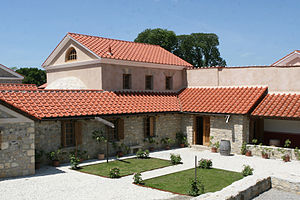|
Vikidia currently has 4,626 articles. Improve it! |
|
Join Vikidia: create your account now and improve it! |
Roman house
Roman houses, (domus in latin) were of several types depending on their location in the city or countryside and on the inhabitants they were designed for. They were at least three different types. Even emperors's palace were called domus.
Insulae[edit | edit source]
Ordinary people lived in apartment blocks called Insulae, a kind of apartment building. It housed most people of lower- or middle-class status (the plebs) and all but the wealthiest from the upper-middle class (the equites).
Insulae were of poor quality, but they did have running water and sanitation. Rooms could be owned or rented. They were built in timber, mud brick, and later primitive concrete.[1] They were restricted in height to about 20 metres.
...in the Roman port town of Ostia.
Domus[edit | edit source]
Houses of the rich and upper classes were lavish. The atrium was the most important part of the house. It was where guests were greeted. The atrium was open in the centre, surrounded at least in part by high-ceilinged porticoes that often contained only sparse furnishings to give the effect of a large space. In the centre was a square roof opening in which rainwater could come, draining inwards from the slanted tiled roof. The master's office was placed so that the master could see what was going on. There were kitchens, bedrooms, a dining room, and a number of open rooms.
Servants would use a servants' entrance, not the main entrance. Slaves could not leave the house without the permission of the master. The domus was not just a house; it was a place of business as well.[2]
Women weaving.
Villas[edit | edit source]
A Roman villa was a Roman country house built for the upper classes. There were two kinds of villas.[3] The villa urbana, was a country seat in easy reach of Rome (or another city). The villa rustica was a farm-house estate, like the later English country house. It was occupied by servants who ran the estate.
In the Empire, there was a concentration of Imperial villas near the Bay of Naples, on the Isle of Capri, at Monte Circeo on the coast and at Antium (Anzio). Wealthy Romans escaped the summer heat in the hills round Rome, especially around Frascati (such as Hadrian's Villa). Cicero had at least seven villas. The oldest of these was near Arpinum, which he inherited. Pliny the Younger had three or four, of which the example near Laurentium is the best known from his descriptions.[4]
Some sumptuous Roman villas featured complex floor mosaics, such as Villa Armira in modern Bulgaria.
Late Roman owners of villas had luxuries like hypocaust-heated rooms with mosaics.
Large villas were important to the Roman economy. They dominated the Po valley, Campania, and Sicily, and were also found in Gaul. Villas were centres of mining, pottery, or horse raising.[5] Villas specializing in shipping olive oil to Roman legions in Germany were a feature of the southern Iberian province of Hispania Baetica.[6] Some luxurious villas have been excavated in North Africa in the provinces of Africa and Numidia, or Fishbourne Palace in Britannia.
References[edit | edit source]
- ↑ Humphrey, John W; John P. Oleson & Andrew N. Sherwood 1998. Greek and Roman technology: a sourcebook. London: Routledge
- ↑ Aldrete, Gregory S. 2004. Daily life in the Roman city. Greenwood Press, 75. ISBN 978-0-313-33174-9
- ↑ Becker, Jeffrey & Terrenato, Nicola 2012. Roman Republican villas: architecture, context, and ideology. Ann Arbor: University of Michigan Press. ISBN 978-0-472-11770-3
- ↑ du Prey, Pierre de la Ruffiniere 1995. The villas of Pliny from antiquity to posterity.
- ↑ Dyson, Stephan L. 2003. The Roman Countryside. London: Duckworth. pp. 49–53. ISBN 0-7156-3225-6.
- ↑ Numerous stamped amphorae from Baetica have been found in Roman sites of northern Gaul.

|
Ancient Rome portal — All pages about Ancient Rome |












